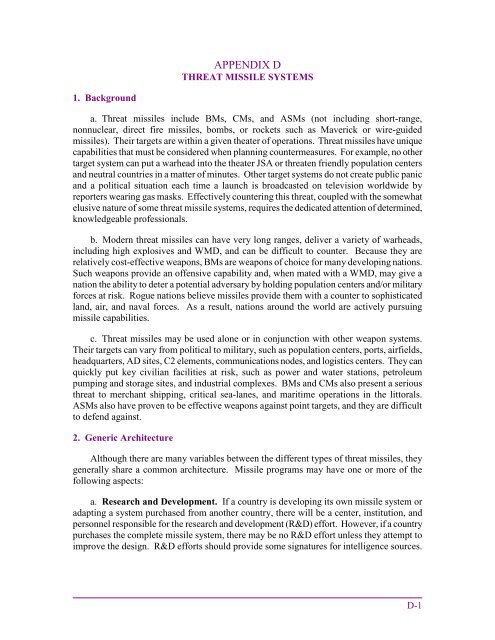JP 3-01 Countering Air and Missile Threats - Defense Innovation ...
JP 3-01 Countering Air and Missile Threats - Defense Innovation ...
JP 3-01 Countering Air and Missile Threats - Defense Innovation ...
Create successful ePaper yourself
Turn your PDF publications into a flip-book with our unique Google optimized e-Paper software.
APPENDIX D<br />
THREAT MISSILE SYSTEMS<br />
1. Background<br />
a. Threat missiles include BMs, CMs, <strong>and</strong> ASMs (not including short-range,<br />
nonnuclear, direct fire missiles, bombs, or rockets such as Maverick or wire-guided<br />
missiles). Their targets are within a given theater of operations. Threat missiles have unique<br />
capabilities that must be considered when planning countermeasures. For example, no other<br />
target system can put a warhead into the theater JSA or threaten friendly population centers<br />
<strong>and</strong> neutral countries in a matter of minutes. Other target systems do not create public panic<br />
<strong>and</strong> a political situation each time a launch is broadcasted on television worldwide by<br />
reporters wearing gas masks. Effectively countering this threat, coupled with the somewhat<br />
elusive nature of some threat missile systems, requires the dedicated attention of determined,<br />
knowledgeable professionals.<br />
b. Modern threat missiles can have very long ranges, deliver a variety of warheads,<br />
including high explosives <strong>and</strong> WMD, <strong>and</strong> can be difficult to counter. Because they are<br />
relatively cost-effective weapons, BMs are weapons of choice for many developing nations.<br />
Such weapons provide an offensive capability <strong>and</strong>, when mated with a WMD, may give a<br />
nation the ability to deter a potential adversary by holding population centers <strong>and</strong>/or military<br />
forces at risk. Rogue nations believe missiles provide them with a counter to sophisticated<br />
l<strong>and</strong>, air, <strong>and</strong> naval forces. As a result, nations around the world are actively pursuing<br />
missile capabilities.<br />
c. Threat missiles may be used alone or in conjunction with other weapon systems.<br />
Their targets can vary from political to military, such as population centers, ports, airfields,<br />
headquarters, AD sites, C2 elements, communications nodes, <strong>and</strong> logistics centers. They can<br />
quickly put key civilian facilities at risk, such as power <strong>and</strong> water stations, petroleum<br />
pumping <strong>and</strong> storage sites, <strong>and</strong> industrial complexes. BMs <strong>and</strong> CMs also present a serious<br />
threat to merchant shipping, critical sea-lanes, <strong>and</strong> maritime operations in the littorals.<br />
ASMs also have proven to be effective weapons against point targets, <strong>and</strong> they are difficult<br />
to defend against.<br />
2. Generic Architecture<br />
Although there are many variables between the different types of threat missiles, they<br />
generally share a common architecture. <strong>Missile</strong> programs may have one or more of the<br />
following aspects:<br />
a. Research <strong>and</strong> Development. If a country is developing its own missile system or<br />
adapting a system purchased from another country, there will be a center, institution, <strong>and</strong><br />
personnel responsible for the research <strong>and</strong> development (R&D) effort. However, if a country<br />
purchases the complete missile system, there may be no R&D effort unless they attempt to<br />
improve the design. R&D efforts should provide some signatures for intelligence sources.<br />
D-1

















